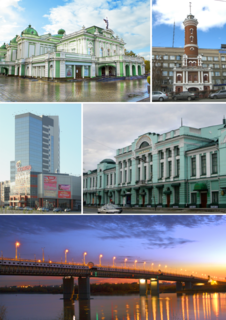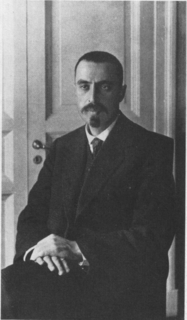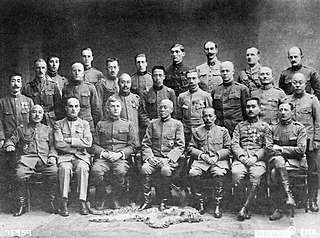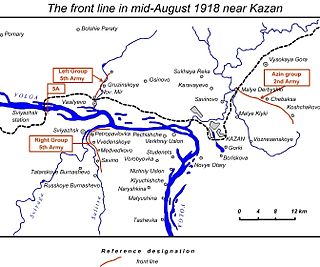
Lavr Georgiyevich Kornilov was a Russian military intelligence officer, explorer, and general of Siberian Cossack origin in the Imperial Russian Army during World War I and the ensuing Russian Civil War. He is today best remembered for the Kornilov Affair, an unsuccessful endeavor in August/September 1917 that was intended to strengthen Alexander Kerensky's Provisional Government, but which led to Kerensky eventually having Kornilov arrested and charged with attempting a coup d'état, and ultimately undermined Kerensky's rule.

Omsk is a city and the administrative center of Omsk Oblast, Russia, located in southwestern Siberia 2,236 kilometers (1,389 mi) from Moscow. With a population of 1,154,116, it is Russia's second-largest city east of the Ural Mountains after Novosibirsk, and seventh by size nationally. Omsk acts as an essential transport node, serving as a train station for Trans-Siberian Railway and as a staging post for the Irtysh River.

Irakli Tsereteli was a Georgian politician and a leading spokesman of the Social Democratic Party of Georgia and later Russian Social Democratic Labour Party (RSDLP) during the era of the Russian Revolutions.

The Far Eastern Republic, sometimes called the Chita Republic, was a nominally independent state that existed from April 1920 to November 1922 in the easternmost part of the Russian Far East. Although theoretically independent, it largely came under the control of the Russian Soviet Federative Socialist Republic (RSFSR), which envisaged it as a buffer state between the RSFSR and the territories occupied by Japan during the Russian Civil War of 1917-1922. Its first president was Alexander Krasnoshchyokov.

The Czechoslovak Legion were volunteer armed forces composed predominantly of Czechs with a small number of Slovaks fighting on the side of the Entente powers during World War I. Their goal was to win the support of the Allied Powers for the independence of Bohemia and Moravia from the Austrian Empire and of Slovak territories from the Kingdom of Hungary, which were then part of the Austro-Hungarian Empire. With the help of émigré intellectuals and politicians such as the Czech Tomáš Garrigue Masaryk and the Slovak Milan Rastislav Štefánik, they grew into a force of over 100,000 strong.

The Russian Civil War spread to the east in May 1918, with a series of revolts along the route of the Trans-Siberian Railway, on the part of the Czechoslovak Legion and officers of the Russian Army. Provisional anti-Bolshevik local governments were formed in many parts of Siberia and other eastern regions during that summer. The Red Army mounted a counter-offensive in the autumn, and in 1919 defeated the White commander Aleksandr Kolchak in Siberia. Smaller-scale conflicts in the region went on until 1923.

The Siberian Intervention or Siberian Expedition of 1918–1922 was the dispatch of troops of the Entente powers to the Russian Maritime Provinces as part of a larger effort by the western powers and Japan and China to support White Russian forces against Soviet Russia and its allies during the Russian Civil War. The Imperial Japanese Army continued to occupy Siberia even after other Allied forces withdrew in 1920.

The Provisional All-Russian Government (PA-RG) was a short-lived government (1918–1920) centred in Omsk in Siberia during the Russian Civil War of 1917–1922. It formed from the Committee of Members of the Constituent Assembly or Komuch and from the Provisional Siberian Government, which consisted mainly of regional politicians and rightist officers and was based at Omsk. The two régimes had previously failed to work effectively together, with rivalry leading to a customs war and to numerous border disputes.

The Provisional Priamurye Government existed in the Far East Russian region of Priamurye, Russia, between May 27, 1921 and October 25, 1922. It was the last Russian state enclave during the Russian Civil War.

Siberian regionalism was a political movement to form an autonomous Siberian polity. It originated in the mid-19th century and reached a high tide with the military activities of Aleksandr Kolchak and Viktor Pepelyayev during the Russian Civil War.

Siberian Republic is the idea that Siberia should be an independent republic.

The People's Army of Komuch was an anti-Bolshevik army during the Russian Civil War that fought in the Volga Region from June to September in 1918.

The Siberian Army was an anti-Bolshevik army during the Russian Civil War, which fought from June 1918 – July 1919 in Siberia – Ural Region.

Alexander Vasilyevich Kolchak KB was an Imperial Russian admiral, military leader and polar explorer who served in the Imperial Russian Navy, who fought in the Russo-Japanese War and the First World War. During the Russian Civil War, he established an anti-communist government in Siberia—later the Provisional All-Russian Government—and was recognised as the "Supreme Leader and Commander-in-Chief of All Russian Land and Sea Forces" by the other leaders of the White movement from 1918 to 1920. His government was based in Omsk, in southwestern Siberia.
The Ufa Directory was a Counter-revolutionary body that was created by the Ufa State Conference on September 23, 1918, in Ufa. It was a merging of the Committee of Members of the Constituent Assembly and the Provisional Siberian Government (Omsk), the former having previously claimed to be the legitimate government of Russia. It lasted barely eight weeks. Its demise was definitely hastened by the Directors' decision to relocate immediately to Omsk, the capital of the PSG and the headquarters of the Siberian Army. Its SR members were not so naïve as to fail to recognize that this relocation was implicitly perilous: "We must put our heads in the lion's mouth," N.D. Avksent'ev informed critics of the move. "Either it will eat us or we will choke it." The government was deposed in a coup organized by Kadets, Cossacks, and leaders of the Siberian Army on 18 November 1918.
The 5th Pri-Amur Corps was a formation of the Siberian Army, part of the anti-Bolshevik White movement during the Russian Civil War. It primarily operated in the Transbaikal region and was headquartered in the city of Chita. The 5th Corps was formed from the Transbaikal Cossacks and various other volunteer forces fighting under Ataman (chief) Grigory Semyonov, as part of his Special Manchurian Unit.

Russian state — is a state proclaimed by the Act of the Ufa State Conference of September 23, 1918 “on the formation of the all-Russian supreme power” in the name of “restoring state unity and independence of Russia” affected by the revolutionary events of 1917, the establishment of Soviet power and the signing of the Soviet government of the treaty of Brest-Litovsk.














